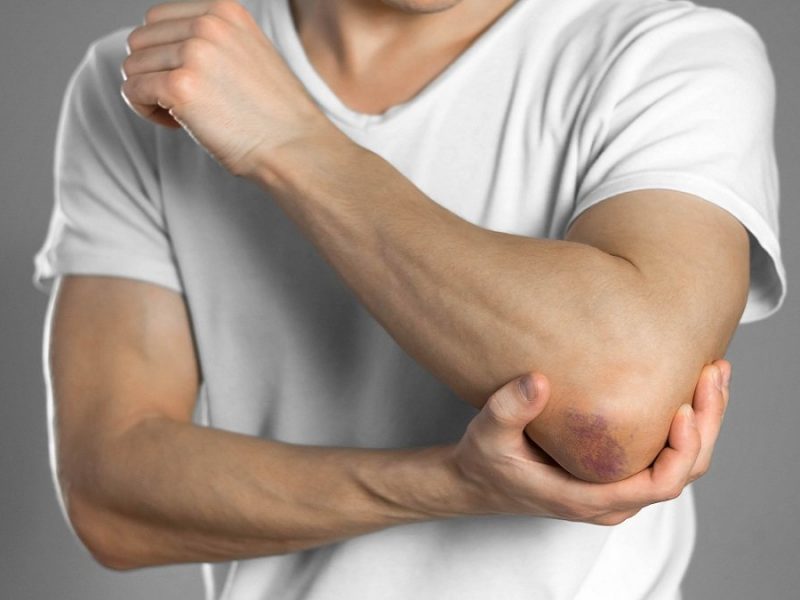For me,
traction aids, in addition to training gloves and the right shoes, are part of the basic equipment for classic strength training. With some exercises, such as the deadlift , so-called lifting straps can be extremely useful for making even faster and better progress. Of course, it is important that you know how to use them correctly to support your training.
In this article I want to bring you closer to the pulling aids as a training tool with their advantages and disadvantages, so that you can optimally benefit from their advantages.
Since I’ve tested a number of pulling aids over the years, I will also give you recommendations as to which pulling aids I have had good experiences with in which situations.
For the sake of clarity, I have divided this article into sections along frequently asked questions about this useful training tool.
One click takes you directly to the section that interests you most. However, I recommend that you take the 5 minutes to read the entire article.
After reading this, you should know enough about pulling aids to be able to decide for yourself whether you need them for your training and how you can use them effectively.
What are pulling aids and what do they bring?
Pulling aids should, as the name suggests, help or facilitate pulling. With various pulling exercises, as the weight or repetitions increase, it can become difficult to hold the weight with your hands. The grip strength is no longer sufficient and ultimately no or fewer repetitions are possible.
By redistributing the tensile load, you need significantly less grip strength with lifting straps. So they help you to do more repetitions in pulling exercises with the same weight.
Especially with complex exercises, such as the classic basic exercises , a large number of muscle groups are involved in the movement in a so-called muscle chain. It is always the case here that there is a limiting factor. A muscle or muscle group is the weakest link in the chain. In pulling exercises, this limiting factor is usually the forearm muscles, which are responsible for grip strength.
With the support of pulling aids, you are now relieving this weakest link in the chain. This allows you to bring the other muscle groups involved much closer to their performance limits. This increases the training effect for these muscles.
Further advantages of training with pulling aids
In addition to the obvious advantages of relieving the forearm muscles and the resulting increased performance potential and training effect, training with the support of straps has other advantages. These benefits are less talked about because at first glance they don’t seem to play an essential role from a pure performance perspective. In fact, their effect on your long-term training success is greater than you might think. This can also speak in favor of selective use of pulling aids.
Improvement of technique with high weight
If the grip strength decreases with higher weights, it can quickly happen that this is exactly the focus during execution. You notice that your hands can no longer grasp the weight firmly and you concentrate fully on your hands. This can lead to the fact that other elements of technology slip out of your perception and you become unclean. It is even worse if you consciously or unconsciously try to compensate for the decrease in grip strength by adjusting the grip or movement.
I keep seeing this, especially with the deadlift, and believe me, the importance of good deadlifting is really essential. This applies to your training success but also to the long-term health and performance of your musculoskeletal system.
Better muscle-mind connection with the target muscles
Here, too, the subject of concentration plays an important role. Perhaps you already knew that your focus is your superpower . Through the maximum concentration and thus the best possible connection between your brain and the target muscles, the control can be significantly improved over time. This in turn ensures an increase in your training performance and even better progress in your training.
Ask yourself: which muscles are you doing the exercise for? Your focus during the exercise should be on these muscles.
When and for what should you use pulling aids?
Now we come to the very specific use cases. Basically, you can use pulling aids for all pulling exercises. However, the question arises as to which exercises and in which situations it makes sense to use it.
For me there is no question that the use of lifting straps can be absolutely useful when deadlifting. Here are significantly larger and more powerful muscle groups than your forearm muscles. In addition, it is particularly important to concentrate on the technique in this exercise, because mistakes can quickly (and slowly) lead to unwanted injuries.
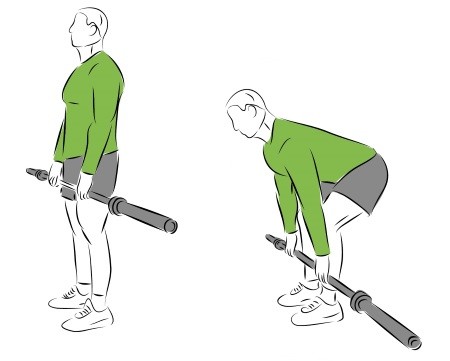
Pulling aids can be very effective when deadlifting insert.
The use of other pulling exercises can also be useful if the volume is very large and in order to work with the target muscles in a particularly focused manner. I have to admit, I’m not a big fan of using straps for support when doing lat pulldowns or barbell rows . However, I definitely see the added value if the larger target muscles were still able to perform better than the relatively small forearm muscles. Especially with the last one or two work sets, it can make sense to concentrate fully on the respective muscles with the help of pulling aids
In general, I also have the principle that as soon as the technique suffers noticeably from a decrease in grip strength, the use of pulling aids as an aid is permitted and makes sense.
If this support is required for several exercises, however, you should also think about what you can do to strengthen your grip strength.
When you shouldn’t use pulling aids
Sometimes I see people who really train with pulling aids for every pulling exercise from the first set. With all the potential advantages, I don’t think that makes sense. Ultimately, with the straps you take your forearm muscles almost completely out of the game. Your grip strength is almost no longer required. As a result, it will continue to sink and your forearm muscles will develop worse or even backwards in relation to your remaining muscles.
If so, you should rather do as many sets as possible without pulling aids and only do the last sets with support in order to properly challenge the target muscles. If you need the support of the drawstrings or hooks for a large proportion of your training sets, then your goal should be to train your forearms in a way that changes that. Ultimately, you probably want the most balanced and functional muscles possible.
Another phenomenon that I have observed quite often is that some people train with pulling aids from the start. However, I would advise you to always learn the technique first until you really master it. Then you can increase the weights so far that the support of the lifting straps helps you to get even more out of your training.
What I also find quite funny is when pulling aids are used for exercises where they don’t really make sense. You now know how they work and the benefits of straps. So think carefully about whether it really makes sense to train with them. As chic as they might look, when you bench press they offer you no added value.
How to put on and use pulling straps correctly
When you buy new pulling aids and unpack them, you first have to put the loose end through the loop so that you can use them.
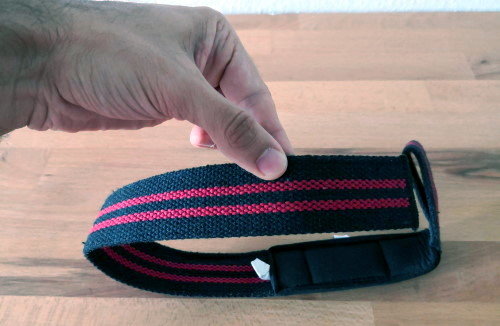
Make sure that you do not twist the strap, otherwise the pulling aid will be uncomfortable to carry and use less than optimal. If you have put the loose end through the loop correctly, it looks like this:
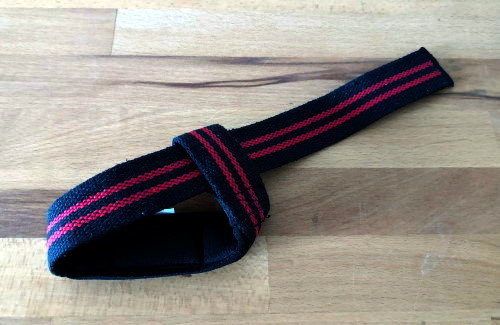
So “assembled” you can now use the lifting straps. Just pull the loop open a little to put your hand through and then pull it back so that it tightly encloses your wrist. The cushion, if your pulling aids have one, is at the level of your wrist on the back of the hand. This is where the largest train is created. The pad makes it much more comfortable on the wrist. The loose end, which you will later use to wrap the barbell with it, runs between your thumb and forefinger with your fingers spread.
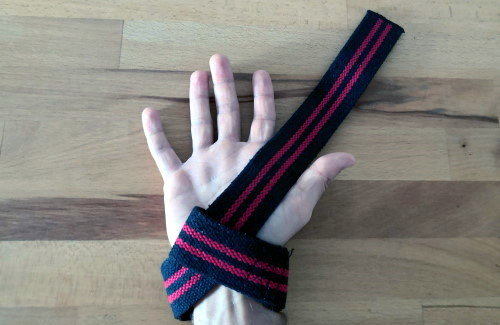
Once you have put it on, you can simply wrap the loose end around the barbell. Try to wrap the pulling aids as tightly as possible and keep your hand as close to the bar as possible. It is easiest to wrap around bars with well-functioning ball bearings. But even with immovable poles you will get the hang of it after a few tries.
The bar should be firmly in your hand without much play. With your fingers you basically only hold the loop closed.
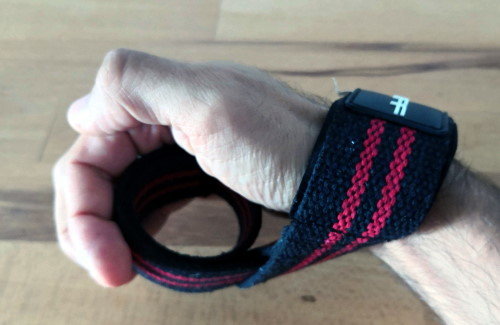
Treat yourself to a few attempts at low weight until you can safely get the pulling aids wrapped. Only then should you use them with heavy weights. Even then, I always advise you to check again before the start of the training set whether the straps are really tight under tension and do not slip. If you are not sure, it is better to recreate it before you start.
An important note on the use of pulling aids
Do not start right away to get everything you can out of the target muscles. If you haven’t trained with support before and are doing it now, that’s a different burden. Your other muscles and also other parts of your musculoskeletal system, such as tendons, ligaments and joints, are not used to the suddenly significantly greater stress. So increase slowly and go to your strength limit after six to eight weeks at the earliest in order not to risk any injuries.
Which pulling aids are right for you?
Over the years I have tried many different types and manufacturers of aids. Based on the experiences I have made during this time and the information I have collected, I want to make your decision for the right pulling aids easier. I will briefly introduce you to different variants, explain their advantages and disadvantages and give you a recommendation for each.
In principle there are two different variants. One with a fixed (metal) hook and a more flexible variant. The flexible variant is much more common and is usually made of cotton fabric and sometimes nylon or leather.
Variant 1: pulling aids with hooks
One thing first: I’m not a big fan of this pulling aid variant. Nevertheless, I would like to introduce them to you briefly, as they can still be used for certain applications.
The advantage of this version is that your hands are completely relieved. No tape has to be wrapped and then still held. You just hook up and you’re good to go. This saves time and allows you to focus even more on the target muscles with certain exercises.
Unfortunately, this also has the disadvantage that the lack of gripping means that contact with the bar is lost. This in turn can have a negative effect on the muscle-mind connection. The execution and ultimately the training stimulus can suffer as a result. That is probably not a problem for everyone. You have to try whether it affects you and does not improve even after a few uses.
Finally, I do not want to go unmentioned that such a tow hook can also be a health risk for you. If you can no longer control the weight properly, you cannot simply let go of the weight with such hooks. In my opinion, this is a not insignificant safety factor, especially with the deadlift, for example.
This pulling aid variant makes the most sense if you want to learn pull-ups and your grip strength is a limiting factor. Mainly because it is much more difficult to work with the other variant here. With the hook you can easily hang yourself in the bar. Otherwise, as I said, it can still be useful if you want to try to focus even more on the target muscles. Here, however, you have to decide for yourself whether this works at all and whether the possible advantages outweigh the disadvantages and justify the higher price.
I’ve tried different variations. Overall, however, I don’t like the variant with the fixed hook and personally haven’t used hooks for a long time. If you still want to try out such hooks, you can try the metal hooks from Armageddon Sports.
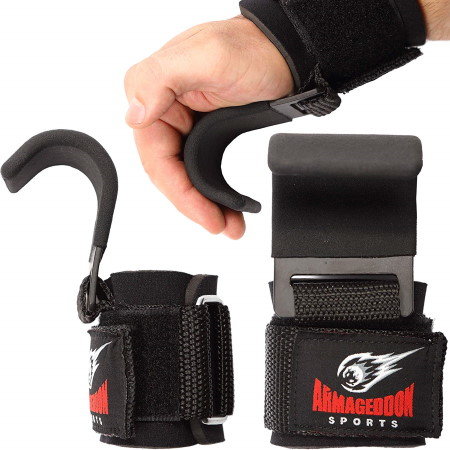
Variant 2: Pulling aid straps made of fabric, leather or nylon?
The cheaper and in my opinion much more versatile and useful variant is the pulling aid as a strap with a loop. They do not completely relieve the forearm muscles, because at least the wrap still has to be held by grasping. However, as explained above, this also has advantages in terms of training feel and safety. At the same time, the relief for the forearms is still very great.
Properly securing the straps to the bar with one hand can get a bit tricky and difficult at first. With a little practice, however, it usually works quite well with the fingers. If you don’t want it to work optimally straight away, just rewind it.
Most pulling aids are made of cotton, which should be sufficient for 99%. Versions made of leather or nylon are sometimes even more tear-resistant and can therefore be used for even greater weight. However, they are also more expensive and do not absorb sweat, which can make them slippery. For a good ten, you can get really good pulling aids made of cotton, with which most people can easily move very heavy weights. I have already lifted over 200 kilograms regularly and without problems with my pulling aids.
I am currently using Fitgriff’s pulling aids and I am very satisfied with them. These are simple and inexpensive but high-quality pulling aids made of fabric with light wrist padding but without any rubber coatings. Everything else is, in my opinion, unnecessary frills.
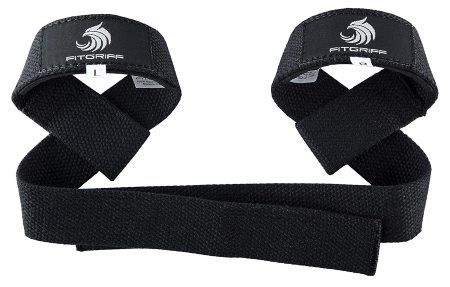
I hope with this article I was able to answer your questions about pulling aids and their correct use. I would be delighted if you would visit my blog again soon. It’s best to follow me directly on Facebook and sign up for the newsletter so that you don’t miss any new articles. If you have any questions, just write me a comment or an email.


